中山大学神经病学2018年考博真题考博试卷
中山大学神经病学2019年考博真题试卷

医学考博真题试卷
攻读博士学位研究生入学考试试卷
中山大学
2019年攻读博士学位研究生入学考试试题
考试科目:神经病学
注意:所有答案一律写在答题纸上,写在试题纸上或其他地方一律不给分。
一、名词解释(每题3分)
1.语义性痴呆
2.视神经炎谱系疾病
3.
6.CADASIL
7.Kluver-Bucy综合征
8.错构
9.Propusion/Festination
10.Kluver-Bucy Syndrome
二、简答题(每题6分)
1.TIA的ABCD2评分标准及危险分层。
2.遗传性共济失调的共同临床表现,并列举三个不同亚型特点。
3.基底神经节损害的临床表现。
4.脊髓亚联合变性的临床表现。
(3)进一步作哪些检查?
(4)治疗?
5.偏头痛的急性期治疗成功的目标。
三、问答题(每题10分)
1.详细描述感觉障碍的类型。
2.大脑中动脉粥样硬化型脑梗死静脉溶栓、血管内取栓的时间窗确定的依据。
3.写出与重症肌无力眼肌型的5个鉴别诊断并写出鉴别点。
4.病例分析:病例资料好像是自身免疫性脑炎。
(1)定位定性诊断是什么?诊断依据?
(2)鉴别诊断的2个疾病及鉴别点?
2014年中山大学临床医学神经内科博士复试真题

中山大学附属第三医院神经内科博士生专业课考试试题学号:_________ 姓名:_________ 成绩:__________一、名词解释(5分×4=20分)1、短暂性全面遗忘症2、Lambert-Eaton综合征3、Ramsay-Hunt综合征4、痴呆二、简答题(10分×3=30分)1、癫痫持续状态的定义及其处理原则2、帕金森病的临床表现3、简述多发性硬化与视神经脊髓炎的鉴别要点三、问答题(25分×2=50分)1、急性缺血性卒中溶栓治疗的适应症和禁忌症2、请述双下肢乏力患者的诊疗思路答案一、名词解释(5分×4=20分)1、短暂性全面遗忘症突然起病的一过性记忆丧失,伴时间、空间定向力障碍,无意识障碍(1’)。
患者自知力保留,较复杂的皮层高级活动如书写、计算力和对话等保留完整,无神经系统其他的异常表现(1’)。
症状持续数分钟或数小时,多不超过24小时(1’),遗留有完全的或部分的对发作期事件的遗忘(1’)。
因颞叶、海马等部位的缺血所致(1’)。
2、Lambert-Eaton综合征自身免疫性疾病,自身抗体的靶器官是神经末梢突触前膜的钙离子通道和Ach囊泡释放区(2’)。
可伴发癌肿(1’)。
表现为四肢近端无力,活动后感疲劳,但短暂用力收缩后肌力反而增强(1’)。
神经高频重复电刺激有高频递增现象(1’)。
3、Ramsay-Hunt综合征膝状神经节单纯疱疹病毒感染(1’),可导致同侧周围性面瘫(额纹消失、不能皱眉,眼裂闭合不全,鼻唇沟浅,口角下垂,示齿偏向健侧,鼓腮不能、不能吹口哨等)(1’)、舌前2/3味觉消失(1’)及听觉过敏(1’),并有乳突部疼痛,耳廓、外耳道感觉减退和外耳道、鼓膜疱疹(1’)。
4、痴呆是由于脑功能障碍而产生的获得性、持续性智能损害综合征(1’),可由脑退行性变引起,也可以由其他原因(如脑血管病、外伤、中毒等)导致(1’),痴呆患者必须有两项或两项以上认知域受损(1’),并导致患者的日常或社会能力明显减退(1’),还可伴发精神行为的异常(1’)。
中山大学医学院解剖学考博专业课神经系统病例分析要点和答案

中山大学医学院解剖学考博专业课神经系统病例分析要点和答案【病例1】从患者左下肢有明显运动障碍、肌张力减退、腱反射消失、肌萎缩等瘫痪特点看,说明不是中枢性(痉挛性)瘫痪而是周围性瘫痪,即为下神经元损伤的弛缓性瘫痪。
又因无感觉障碍,说明不是周围神经受损(周围神经损伤一般兼有运动和感觉障碍),故病变在脊髓前角(左侧) (图1)。
从瘫痪累及左侧整个下肢看,肌萎缩重在足、小腿和大腿后面,脊髓受损伤的主要节段在腰骶膨大的下段(L1~S4)。
根据患者起病急,有高热等急性炎症的症状,诊断为急性脊髓前角灰质炎(小儿麻痹症) 后遗症。
【病例2】本病临床诊断为脊髓空洞症,这是一种缓慢进行的脊髓变性疾病,主要病变是髓内有空洞形成和胶质增生。
患者脊髓空洞自中央管向周围发展(图2),向前破坏了在白质前连合两侧痛、温觉的交叉纤维,出现双侧对称性痛、温觉障碍。
因未累及后索,触觉和深感觉仍然存在。
空洞扩大侵犯了前角时,造成病变相应节段的肌肉弛缓性瘫痪和肌肉萎缩。
从痛、温觉缺失的皮肤节段和肌肉萎缩看,病变主要在脊髓C8和T1节段。
眼睑下垂和瞳孔缩小是Horner征的主要表现。
表明T1-2的中间外侧核受损。
因脊髓T1-2侧角细胞发出的交感神经节前纤维,经颈交感干上升至颈上神经节中继,节后纤维支配瞳孔开大肌和提上睑的平滑肌(Müller氏肌)等。
当T1侧角细胞受损伤时,即出现上睑下垂和瞳孔缩小。
【病例3】临床诊断为脊髓痨,这是一种慢性进展的脊髓实质梅毒,主要病变为脊髓后索和后根发生变性和萎缩(图3)。
患者脐平面以下双侧深感觉,两点辨别觉和腱反射消失,说明病变损坏双侧脊髓后索,且病变上界在T10节段。
触觉不完全消失是触觉还可通过脊髓丘脑前束向上传导的缘故。
患者出现的行走困难,步态不稳是由于肌关节感觉缺失所致的感觉性共济失调,它与小脑疾病的共济失调不同是通过视觉帮助可以在很大程度上得到控制,故Romberg征阳性。
而小脑性共济失调则闭眼和睁眼对直立稳定性都影响不大(Romberg征阴性)。
中山大学病理生理学2015--2019年考博真题
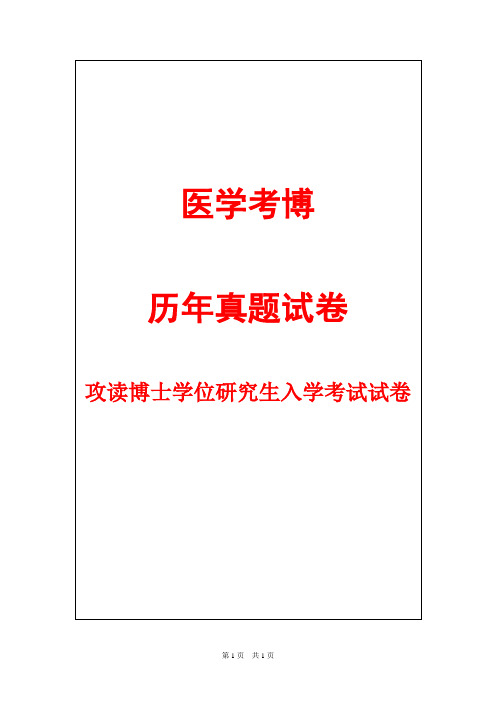
1.Cell signal transduction
2.Hepatic insufficiency
3.paroxysmal nocturnal dyspnea
4.hypovolemic shock
二、简答题
1.试述应激时下丘脑垂体-肾上腺皮质体统对机体的影响。
2.试述休克和DIC的关系。
4、myocardial stunning
二、问答题(20分*4题=80分)
1.肝性脑病相关的神经递质种类及其导致肝性脑病的机制。
2.长期高血压引起心脏衰竭的发病机制。
3.全身适应性综合征各期的神经内分泌变化及其生理效应。
4.试述细胞信号转导异常引起霍乱的机制。
中山大学
2016年攻读博士学位研究生入学考试试题
4.热休克蛋白
5.APC抵抗
二、论述题
1.氨在肝性脑病中对神经递质的影像。
2.慢性肾脏病合并高血压的机制。
3.代谢性酸中毒对循环系统的影像。
4.休克早起(代偿期)微循环的特点及其机制,以及对心脏、肾脏、脑功能的影像。
中山大学
2017年攻读博士学位研究生入学考试试题
考试科目:病理生理学
注意:所有答案一律写在答题纸上,写在试题纸上或其他地方一律不给分。
一、名词解释(每题5分,共20分)
1.renal osteodystrophy
2.hepatic encephalopathy
3.recessive edema
4.non-reflow phenomenon
二、简答题(每题20分,共80分)
1.心衰代偿反应时血容量增加的机制及对机体的意义。
2.DIC引起出血的机制。
3.ARDS患者为什么常出现I型呼吸衰竭。
2018年全国医学统考考博英语真题与答案
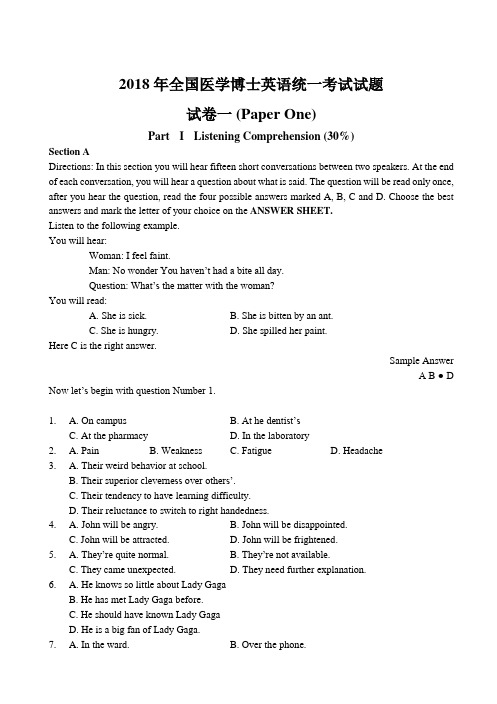
2018 年全国医学博士英语统一考试试题试卷一 (Paper One)Part I Listening Comprehension (30%)Section ADirections: In this section you will hear fifteen short conversations between two speakers. At the end of each conversation, you will hear a question about what is said. The question will be read only once, after you hear the question, read the four possible answers marked A, B, C and D. Choose the best answers and mark the letter of your choice on the ANSWER SHEET.Listen to the following example.You will hear:Woman: I feel faint.Man: No wonder You haven’t had a bite all day.Question: What’s the matter with the woman?You will read:A. She is sick.B. She is bitten by an ant.C. She is hungry.D. She spilled her paint.Here C is the right answer.Sample AnswerA B ● D Now let’s begin with question Number 1.1. A. On campus B. At he dentist’sC.At the pharmacyD. In the laboratory2. A. Pain B. Weakness C. Fatigue D. Headache3. A. Their weird behavior at school.B. Their superior cleverness over others’.C. Their tendency to have learning difficulty.D. Their reluctance to switch to right handedness.4. A. John will be angry. B. John will be disappointed.C. John will be attracted.D. John will be frightened.5. A. Th ey’re quite normal. B. They’re not available.C. They came unexpected.D. They need further explanation.6. A. He knows so little about Lady GagaB. He has met Lady Gaga before.C. He should have known Lady GagaD. He is a big fan of Lady Gaga.C. In the emergency room.D. On their way to the hospital8. A. Health care B. Health reformC. Health educationD. Health maintenance9. A. Learning to act intuitively.B. Learning to argue academically.C. Learning to be critical of oneself.D. Learning to think critically and reason10. A. She is a pharmacist. B. She is a medical doctor.C. She is a scientist in robotics.D. She is a pharmacologist.11. A. She’s pessimistic about the future.B. She’s pessimistic about the far future.C. She’s optimistic about the far future.D. She’s optimistic about the near future.12. A. Negligence may put a patient in danger.B. Patients must listen to doctors and nurses.C. Qualified doctors and nurses are in bad need.D. Patients should be careful about choosing the right hospital.13. A. The man works at eh ER.B. The man can do nothing but wait.C. The woman’s condition is critical.D. The woman is a capable paramedic.14. A. A gynecologist. B. A psychologistC. A neurologist.D. A nephrologist.15. A. She has only one friend.B. She isolates herself from others.C. She suffers from a chronic disease.D. She is jobless and can’t find a job.Section BDirections: In this section you will hear one conversation and two passages, after each of which, you will hear five questions. After each question, read the four possible answers marked A, B, C and D. Choose the best answer and mark the letter of your choice on the ANSWER SHEET.DialogueQuestions 16-20 are based on the following dialogue.16. A. Because she couldn’t do other jobs well.B. Because it was her dream since childhood.C. Because she was fed up with all her previous jobs.D. Because two professors found talent in her and inspired her to do it.17. A. The Self/Nonself Model B. The Danger ModelC. The vaccination theoryD. The immunological theory18. A. Being overactive B. Being mutantC. Being selectiveD. Being resistant19. A. It can help cure most cancers.B. It can help develop new drugs.C. It can help most genetic diseases.D. It can help change the nature of medicine.20. A. We should ignore the resistance.B. We should have the model improved.C. We should have the experiments on animals.D. We should move from animals to human.Passage One21. A. The profits form medical tourism.B.The trendy phenomenon of medical tourism.C.The soaring health care costs around the word.D.The steps to take in developing medical tourism22. A. Affordable costs B. Low pace of livingC. Five-star treatmentD. Enjoyable health vacation23. A. It is a$100 billion business already.B. It is growing along with medical tourism.C. Its costs are skyrocketing with medical tourism.D. It offers more medical options than western medicine.24. A. To set up a website for blogging about medical tourism.B. To modify our lifestyles and health behaviors.C. To buy and affordable medical insurance.D. To explore online to get well informed.25. A. A travel brochure.B. A lecture on medical tourism.C. A chapter of a medical textbook.D. A webpage promotional material.Passage TwoQuestions 26-30 are based on the following passage.26. A. Song sparrows take good care of their babies.B. Young song sparrows back the skills and experience of their parents.C. There are different kind of song sparrows in different seasons.D. Young and old song sparrows experience climate change different.27. A. In the warmer spring B. In the hottest summerC. In the coolest autumnD. In the coldest winter28. A. Because they lack the skill and experience to find food.B. Because they have not developed a strong body yet.C. Because they cannot endure the unusual heat.D. Because they cannot find enough food.29. A. They are less sensitive to the effect of climate change thanks to their parents.B. They are quick to develop strong bodies to encounter climate change.C. They experience food insufficiency due to climate change.D. They are as sensitive to climate change as the juveniles.30. A. Body size B. Migration routeC. Food preferenceD. Population growthPart Ⅱ Vocabulary (10%)Section ADirections: In this section, all the sentences are incomplete. Four words or phrases marked A, B, C and D are given beneath each of them. You are to choose the word or phrase that best completes the sentence, then mark your answer on the ANSWER SHEET.31.The medical team discussed their shared ____to eliminating this curable disease.A.obedienceB. susceptibilityC. inclinationD. dedication32. Many of us are taught from an early age that the grown-up response to pain, weakness, oremotional_____is to ignore it, to tough it out.A. TurmoilB. rebellionC. temptationD. relaxation33. Those depressed kids seem to care little about others,____communication and indulge in theirown worlds.A. put downB. shut downC. settle downD. break down34. The school board attached great emphasis to____ in students a sense of modesty and a sense ofcommunity.A. dilutingB. inspectingC. instillingD. disillusioning35. Our brain is very good at filtering out sensory information that is not______to what we need tobe attending to.A. pertinentB. permanentC. precedentD. prominent36. New studies have found a rather____correlation between the presence of small particles andboth obesity and diabetes.A. collaboratingB. comprehendingC. compromisingD. convincing37. We must test our____about what to include in the emulation and at what level at detail.A. intelligenceB. imitationsC. hypothesisD. precautions.38. We must____the problem____, which is why our map combines both brain structure andfunction measurements at large scale and high resolution.A. set...backB. take...overC. pull...inD. break...down39. Asthma patient doesn’t need continuous treatment because his symptoms are rather____thanpersistent.A. intermittentB. precedentC. dominantD. prevalent40. It is simply a fantastic imagination to_____that one can master a foreign language overnight.A. conceiveB. concealC. convertD. conform Section BDirections: Each of the following sentences has a word or phrase underlined. There are four words or phrases beneath each sentence. Choose the word or phrase which can best keep the meaning of the original sentence if it is substituted for the underlined part. Mark your answer on the ANSWER SHEET.41. The truly competent physician is the one who sits down, senses the “mystery”of anotherhuman beings, and often the simple gifts of personal interest and understanding.A. imaginableB. capableC. sensibleD. humble42. The physician often perceived that treatment was initiated by the patient.A. conservedB. theorizedC. realizedD. persisted43. Large community meals might have served to lubricate social connections and alleviatedtensions.A. facilitateB. intimidateC. terminateD. mediate44. Catalase activity reduced glutathione and Vitamin E levels were decreased exclusively insubjects with active disease.A. definitelyB. trulyC. simplyD. solely45. Ocular anomalies were frequently observed in this cohort of offspring born after in vitrofertilization.A. FetusesB. descendantsC. seedsD. orphans46. Childhood poverty should be regarded as the single greatest public health menace facing ourchildren.A. breachB. griefC. threatD. abuse47. A distant dream would be to deliberately set off quakes to release tectonic stress in a controlledway.A. definitelyB. desperatelyC. intentionallyD. identically48. Big challenges still await companies converting carbon dioxide to petrol.A. applyingB. relatingC. relayingD. transforming49. Concern have recently been voiced that the drugs elicit unexpected cognitive side effects, suchas memory loss, fuzzy thinking and learning difficulties.A. ensueB. encounterC. impedeD. induce50. A leaf before the eye shuts out Mount Tai, which means having one’s view of the importantovershadowed by the trivial.A. insignificantB. insufficientC. substantialD. unexpectedPart ⅢCloze (10%)Directions: In this section there is a passage with ten numbered blanks. For each blank, there are four choices marked A, B, C and D on the right side. Choose the best answer and mark the letter of yourchoice on the ANSWER SHEIET.The same benefits and drawbacks are found when using CT scanning to detect lung cancer—the three-dimensional imaging, improve detection of disease but creates hundreds of images that increase a radiologist’s workload, which, 51 , can result in missed positive scans.Researchers at University of Chicago Pritizker School of Medicine presented 52 data on a CAD (computer-aided diagnosis) program they’ve designed that helps radiologist spot lung cancer 53 CT scanning. Their study was 54 by the NIH and the university.In the study, CAD was applied to 32 low-dose CT scanning with a total of 50 lung nodules, 38 of which were biopsy-confirmed lung cancer that were not found during initial clinical exam. 55 the 38 missed cancers,15 were the result of interpretation error (identifying an image but 56 it as non cancerous) and 23 57 observational error(not identifying the cancerous image).CAD found 32 of the 38 previously missed cancers (84% sensitivity), with false-positive 58 of 1.6 per section.Although CAD improved detection of lung ca ncer, it won’t replace radiologists, said Sgmuel G Armato, PhD, lead author of the study.” The computer is not perfect,”Armato said.” It will miss some cancers and call some things cancer that 59 . The radiologists can identify normal anatomy that the computer may 60 something suspicious. It’s a spell-checker of sorts, or a second opinion.51.A. in common B. in turn C. in one D. in all52.A. preliminary B. considerate C. deliberate D. ordinary53.A. being used B. to use C. using D. use54.A. investigated B. originated C. founded D. funded55.A. From B. Amid C. Of D. In56.A. disseminating B. degenerating C. dismissing D. deceiving57.A. were mistaken for B. were attributed to C. result in D. gave away to58.A. mortalities B. incidences C. images D. rates59.A. don’t B. won’t C. aren’t D. wasn’t60.A. stand for B. search for C. account for D. mistake forPart Ⅳ Reading Comprehension (30%)Directions: In this part there are six passages, each of which is followed by five questions. For each question there are four possible answers marked A, B, C and D. Choose the best answer and mark the letter of your choice on the ANSWER SHEET.Passage OneWhen Tony Wagner, the Harvard education specialist, describes his job today, he says he’s“a translator between two hostile tribes”—the education world and the business world, the people who teach our kids and the people who give them jobs. Wagner’s ar gument in his book “Creating Innovations: The Making of Young People Who Wil l Change the World” is that our K-12 and college tracks are not consistently “adding the value and teaching the skills that matter most in themarketplace.”This is dangerous at a time when there is increasingly to such things as a high-wage, middle-skilled job—the thing that sustained the middle class in the last generation. Now, there is only a high-wage, high-skilled job. Every middle-class job today is being pulled up, out or down faster than ever. That is, it either requires more skill or can be done by more people around the world or is being buried made obsolete faster than ever. Which is why the goal of education today, argues Wagner, should not be to make every child “college ready” but “innovation ready”—ready to add value to whatever they do.That is a tall task. I tracked Wagner down and asked him to elaborate. “Today,” he said via e-mail,” because knowledge is available on every Internet-connected device, what you know matters far less than what you can do with what you know. The capacity to innovate—the ability to solve problems creatively or bring new possibilities to life and skills like critical thinking,communication and collaboration are far more important than acade mic knowledge. As one executive told me, “We can teach new hires the content. And we will have to because it continues to change, but we can’t teach them how to think—to ask the right questions—and to take initiative.”My generation had it easy. We got to “find” a job. But, more than ever, our kids will have to “invent” a job. Sure, the lucky ones will find their first job, but, given the pace of change today, even they will have to reinvent, re-engineer and reimagine that job much often than their parents if they want to advance in it.“Finland is one of the most innovative economics in the world,”Wagner said,” and it is the only country where students leave high school ‘innovation-ready.’ They lea rn concepts and creativity more than facts, and have a choice of many elective—all with a shorter school day, little homework, and almost no testing. There are a growing number of “reinvented”colleges like the Olin College of Engineering, the M.I.T. Media L ab and the “D-school” Stanford where students learn to innovate.”61.In his book, Wagner argues that _____.A.the education world is hostile to our kidsB.the business world is hostile to those seeking jobsC.the business world is too demanding on the education worldD.the education world should teach what the marketplace demands62. What does the “tall task” refer to in the third paragraph?A. Sustaining the middle class.B. Saving high-wage, middle-skilled jobs.C. Shifting from “college ready” in “innovation ready.”D. Preventing middle-class jobs from becoming obsolete fast.63. What is mainly expressed in Wagner’s e-mail?A. New hires should be taught the content rather than the ways of thinking.B. Knowledge is more readily available on Internet-connected devices.C. Academic knowledge is still the most important to teach.D. Creativity and skills matter more than knowledge.64. What is implied in the fourth paragraph?A. Jobs favor the lucky ones in every generation.B. Jobs changed slowly in the autho r’s generation.C. The author’s generation led an easier life than their kids.D. It was easy for the author’s generation to find their first job.65. What is the purpose of the last paragraph?A. to orient future educationB. to exemplify the necessary shift in educationC. to draw a conclusion about the shift in educationD. to criticize some colleges for their practices in educationPassage TwoBy the end of this century, the average world temperature is expected to increase between one and four degrees, with widespread effects on rainfall, sea levels and animal habitats. But in the Arctic, where the effects of climate change are most intense, the rise in temperature could be twice as much.Understanding how Arctic warming will affect the people, animals, plant and marine life and economic activity in Canada’s North are important to the country’s future, says Kent Moore, and atmospheric physicist at University of Toronto Mississauga who is participating in a long-term, international study of the marine ecosystem along the Beaufort Sea, from Alaska to the Mackenzie delta.The study will add to our knowledge of everything from the extent of sea ice in the region to how fish stocks will change to which areas could become targets for oil and gas exploration to the impact on the indigenous people who call this part of the country home.Moore, who has worked in the Arctic for more than 20 years, says his research has already found that thinning sea ice and changes in wind patterns are causing an important change in the marine food chain: phytoplankton(浮游植物)is blooming two to three weeks earlier. Many animals time their annual migration to the Arctic for when food is plentiful, and have not adapted to the earlier bloom. “Animal behavio r can evolve over a long time, but these climate changes are happening in the space of a decade, rather than hundreds of years,” says Moore,“Animals can’t change their behavior that quickly.”A warmer Arctic is expected to have important effects on human activity in the region, as the Northwest Passage becomes navigable during the summer, and resource extraction becomes more feasible. Information gained from the study will help government, industry and communities make decisions about resource management, economic development and environmental protection.Moore says the study—which involves Canadian, American and European researchers and government agencies—will also use a novel technology to gather atmospheric data: remotely piloted drones. “The drones have the capability of a large research aircraft, and they’re easier to deploy,” he says, showing the researchers to gather information on a more regular basis than they would be able to with piloted aircraft.66. By the end of this century, according to the author, global warming will_____.A. start to bring about extreme weather events to humans and animalsB. increase the average world temperature by four degreesC. cause more damages to the whole world than expectedD. affect the Arctic more than any other parts of the earth67. To help understand the destructive mechanism of Arctic warming, as indicated by the passage,the international study ____.A. is conducted with every single discipline of University of TorontoB. pioneers in pursuing the widespread effects of climate change.C. involves so many countries for different investigationsD. is intended to deal with various aspects in research68. When he says, “Animals can’t change their behavior that quickly,” what does Moore mean bythat quick?A. The migration of the animals to the Arctic.B. The widespread effects of global warming.C. The rate of the climate change in the Arctic.D. The phytoplankton within the marine ecosystem.69. According to the author, to carry out proper human activities in the Arctic_____.A. becomes more difficult than ever before.B. is likely to build a novel economy in the region.C. will surely lower the average world temperature.D. needs the research-based supporting information.70. With the drones deployed, as Moore predicts, the researchers will_____.A. involve more collaborating countries than they do now.B. get more data to be required for their research.C. use more novel technologies in research.D. conduct their research at a regular basis.Passage ThreeSkilled clinical history-taking and physical examination remain essential as the basis of the disease diagnosis and management, aided by investigations such as radiological or biochemical tests. Technological advances over the past few decades mean that such investigations now can be refined, or even replaced in some cases, by the measurement of genetic or genomic biomarkers. The molecular characteristics of a disorder or the genetic make-up of an individual can fine tune a diagnosis and inform its management. These new capabilities, often termed “stratified(分层的)” or “personalized” medicine, are likely to have profound effect on the practice of medicine and service delivery.Genetic medicine, which uses genetic or genomic biomarkers in this way, has, until recently, been the province of a small minority of specialized physicians who have used it to diagnose or assess risk of inherited disease. Recognition that most disease has a genetic component, the development and application of new genetic tests to identify important disease subsets and the availability of cost-effective interventions mean that genetic medicine must be integrated more widely across healthcare services. In order to optimize benefit equitably across the population, physicians and services need to be ready to change and adapt to new ways of working.Perhaps the greatest challenge is to ensure the readiness of physicians to use these genomic technologies for maximum effect, so that genetic medicine is incorporated into mainstream specialties. For some clinicians, particularly those involved in clinical research, these advances are already a reality.However, a sizable majority do not yet recognize the relevance of genetics for their clinical practice, perceiving genetic conditions to be rare and untreatable. Maximizing genomic opportunities also means being aware of their limitations, media portrayals that indicate that genetic information gives clear-cut answers are often unrealistic. Indeed, knowing one’s entire genomic seq uence is no the crystal ball of our future that many hope it to be,and physicians will need to be more familiar with what is hype(鼓吹)and what is reality for the integration of genetics into mainstream medicine to be successful.Finally, both professional and public should have a realistic view of what is possible. Although the discovery of genetic risk factors in common diseases such as heart disease and cancer has led to important insights about disease mechanisms, the predictive power of individual genetic variants is often very low. Developments in bioinformatics will need to evolve considerably before the identification of a particular combination of genetic variants in an individual will have clinical utility for them.71.Which of the following statements does the author most probably agree with?A.Personalized medicine will greatly change the practice of medicine.B.Genetic biomarkers have been largely refined over the past.C.Physical examination remains essential in tine tuning a diagnosis.D.Clinical history-taking is no longer important in the genetic era.72.What, according to the second paragraph, can be said of genetic medicine?A. It can offer solutions to all inherited diseases.B. It has been widely recognized among the physicians.C. It necessitates adaptation of the healthcare community.D. It is monopolized by a small minority of specialized physicians.73. The future of the genomic technologies, for the most part, lies in_____.A. the greater potential of treating rare diseasesB. the greater efforts in the relevant clinical researchC. the greater preparedness of the physicians to employ themD. the greater publicity of their benefits in the media portrayals74. In the last paragraph, the author cautions against_____.A. underestimation of the importance of the genetic risk factorsB. unrealistic expectation of the genetic predicative powerC. abuse of genetic medicine in treating common diseasesD. unexpected evolution of the bioinformatics.75. Which of the following can best summarize the main idea of the passage?A. Genetic medicine should be the mainstream option for physicians.B. Genetic medicine poses great challenges to medical practice.C. Genetic medicine will exert great influence on medicine.D. Genetic medicine is defined as “stratified” medicine.Passage FourMisconduct is a word that is always on professors’ minds. Incidents in the news tend to describe the most serious violations of scientific standards, such as plagiarism for fabricating data. But these high-profile infractions(违法)occur relatively rarely. Much more frequent are forms of misconduct that occur as part of the intimate relationship between a faculty member and a student.Faculty members don’t need to commit egregious acts such as sexual harass ment or appropriation of students’work to fail in their responsibility to their charges. Being generally negligent as teachers and mentors should also be seen as falling down on the job.What we found most interesting was how respondents had less vehement(强烈的)reactions to a host of questionable behaviors. In particular, they said that faculty members should avoid neglectful teaching and mentoring. These included routinely being late for classes, frequently skipping appointments with advisees, showing favoritism to some students, ignoring those whose interests diverged from their own, belittling colleagues in front of students, providing little or no feedback on students’ theses or dissertations, and take on more graduate advisees than they could handle.The vast majority of US faculty members have simply not been taught how to teach. And these responses suggest that they are subjecting young scientists-in-training to the same neglect.To address this systemic issue, we must do a better job of exposing the current and next generations of scientists to the rules of proper mentoring through seminars. For instance, on online modules. The societies of academic disciplines, institutions and individual departments can play a big part here, by developing codes of conduct and clear mechanisms for students report violations.The most serious behaviors are relatively easy to spot and address, but “inadequate teaching”can be subjective. Still, if universities establish specific rules for academics to follow, real patterns of abuse will be easier to find. For instance, these rules could stipulate that professors must return substantive feedback on drafts within 15 days, provide more than just negative feedback during a student’s oral defense of their thesis, or be availa ble regularly to answer questions.To deal with faculty members who consistently fall short, universities should establish teaching-integrity committees, similar to the research-integrity committees that handle issues of scientific misconduct. These could receive reports from students and decide what action to take, either by following a due process laid out in the faculty manual, or simply by adopting the same process as that of other committees, such as for tenure applications.76.What is implied in the first two paragraphs?A. The misconducts are widely exposed in the news.。
权威2018年中山大学博士研究生入学考试内科真题(考生回忆)

权威2018年中山大学博士研究生入学考试内科真题(考生回
忆)
2018年中山大学博士研究生入学考试内科真题(考生回忆)
1. 血液:试述根据红细胞大小如何对贫血进行分类,大细胞性贫血有哪些疾病
2. 风湿:病例分析,关于(类风湿关节炎),要求写出诊断,并列举治疗该病的7个药物
3. 内分泌:试述甲状腺功能亢进的药物治疗,剂量疗程,及注意事项
4. 呼吸:关于ARDS 2000柏林诊断标准
5. 心内:病例分析,患者胃肠道术后送ICU,五小时后(心电图示无P波,室率108/min,烦躁,焦虑),你作为住院总医生该如何处理?
6. 肾内:试述急性肾衰竭行血液透析的指征
7. 消化:NASID类药物造成的消化性溃疡该如何处理?
专业题:
内分泌:试述低钾血症的诊断思路。
中山大学生物化学(2047)2018年考博真题试卷

二、简答题(5分*6) 1. 蛋白质变性、复性 2. 谷氨酸脱氨基,缺乏十五中的谷氨酸 3. 脱氨基作用是否受阻、 酶变构、共价修饰的异同 4. 信号转导、AC\GC的异同 非编码RNA的种类 5. 蛋白质和核酸相互作用的实验
三、问答题(34分,5选3) 1. 乳酸循环 LPL、apo cII基因缺陷 2. 脂蛋白代谢异常,血脂的变化? 3. ATP为什么是能量的中心 4. P53 DNA体内复制、PCR
中山大学
医学考博真题试卷
攻读博士学位研究生入学考试试卷
中山大学
2018年攻读博士学位研究生入学考试试题
考试科目:生物化学(2047) 注意:所有答案一律写在答题纸上,写在试题纸上或其他地方一律不给分。 一、名词解释(3分*10)
第1页ห้องสมุดไป่ตู้共1页
1. molecular chaperone nucleosome 2. Waruburg Rffecct 3. 呼吸链 4. erythropotein(EPO) 5. SD序列 6. 代谢组学 7. 基包打靶 8. 外泌体 9. 锌指
中山大学2002,2005,2007,2011,2015--2019年考博真题+资料
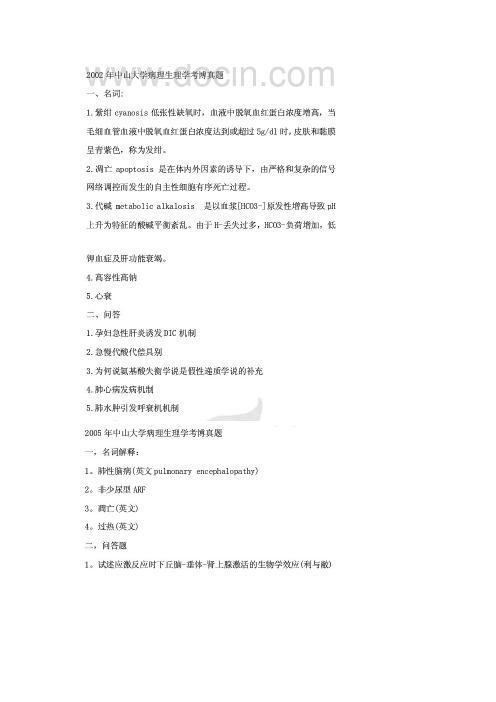
2).呼吸性酸中毒(respiratory acidosis)是指因CO2排出障碍或CO2吸入过多,导致血浆H2CO3浓度升高、PH值呈降低趋势为特征的酸碱平衡紊乱类型。
3).代谢性碱中毒(metabolic alkalosis)指细胞外液碱增多和/或H+丢失而引起的以血浆HCO3-增多、PH值呈上升趋势为特征的酸碱平衡紊乱类型。
3.代谢性酸中毒对循环系统的影像。
4.休克早起(代偿期)微循环的特点及其机制,以及对心脏、肾脏、脑功能的影像。
中山大学考博病理生理学名词解释总结
1.septic shock=感染性休克:在sepsis的基础上病情持续加重,虽大量补液但仍发生低血压或需要应用血管活性药物,存在灌注异常表现;但如合并使用影响肌收缩的药物或血管加压药,可以不出现低血压。
中山大学
2015年攻读博士学位研究生入学考试试题
考试科目:病理生理学
中山大学神经病学2013年考博真题试卷
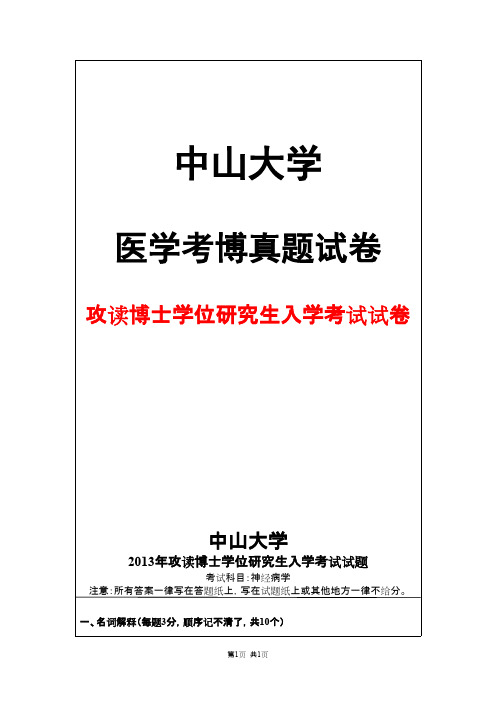
医学考博真题试卷
攻读博士学位研究生入学考试试卷
中山大学
2013年攻读博士学位研究生入学考试试题
考试科目:神经病学 注意:所有答案一律写在答题纸上,写在试题纸上或其他地方一律不给分。 一、名词解释(每题3分,顺序记不清了,共10个)
第1页 共1页
Charcot关节、脑动脉盗血综合征、翼状肩胛、剂末恶化、脊髓半切综合征、扳机 点、Wernicke失语、多发性肌炎、线粒体遗传病 二、简答题(每题6分) 1.节段性分离性感觉障碍的病变部位及临床表现; 2.动态突变性遗传病的定义及病名举例(3个); 3.视交叉及视束损伤的表现及常见病因; 4.蛛网膜下强出血常见并发症的临床表现; 5.去大脑皮层状态的临床表现。 三、论述题(每题10分) 1.全身强直-阵挛性癫痫持续状态如何用药物停止发作并预防复发; 2.重症肌无力危象的治疗; 3.病例分析(脑出血的诊断和治疗,顺便还考了意识障碍的鉴别); 4.阿尔茨海默病的临床特征。
第1页 共1页
神经内科考博试题及答案

神经内科考博试题及答案神经内科是医学中研究神经系统疾病的领域,涉及诊断和治疗多种神经系统疾病。
如果你正准备考博,以下是一些关于神经内科的常见考题及答案,希望能对你的考试备考有所帮助。
1. 什么是帕金森病?请简要描述其临床表现和病因。
答:帕金森病是一种进行性神经系统疾病,其主要特征包括肌肉僵硬、震颤和运动不协调。
常见症状包括手部震颤、姿势僵直、步态异常和面部表情缺失。
帕金森病的病因尚不完全清楚,但可能与遗传因素、环境因素和神经递质的异常有关。
2. 什么是脑卒中?请简要描述其类型和常见症状。
答:脑卒中是一种突发性的脑血管疾病,常见类型包括缺血性脑卒中和出血性脑卒中。
缺血性脑卒中是由于脑周围血管的堵塞而导致的,而出血性脑卒中是由于脑血管破裂导致脑内出血。
常见症状包括突发的面瘫、肢体无力、言语困难和意识障碍。
3. 什么是阿尔茨海默病?请简要描述其临床表现和治疗方法。
答:阿尔茨海默病是一种慢性进行性神经系统疾病,主要表现为记忆力减退、认知障碍和行为改变等。
阿尔茨海默病的确切病因不明,但与神经元损伤和β-淀粉样蛋白在脑内沉积有关。
治疗方法包括药物治疗、康复训练和支持性疗法等。
4. 什么是癫痫?请简要描述其发作类型和治疗方法。
答:癫痫是一种慢性神经系统疾病,其主要特征是反复发作的癫痫发作。
常见的癫痫发作类型包括全身强直-阵挛性发作、部分性发作和失神发作等。
癫痫的治疗方法主要包括药物治疗、手术治疗和生活方式管理。
5. 什么是多发性硬化症?请简要描述其临床表现和诊断方法。
答:多发性硬化症是一种自身免疫性疾病,其特点是神经系统多发性病变。
临床表现包括肢体无力、感觉异常、平衡困难和视力问题等。
诊断多发性硬化症主要依靠临床症状、神经影像学检查和脑脊液分析等。
以上是关于神经内科常见疾病的考博试题及答案。
希望这些内容对你的备考有所帮助。
在准备考试时,建议你结合相关教材和参考资料进行更深入的学习和理解,以便更好地应对考试。
祝你考试顺利!。
中山大学解剖考博真题

中山大学医学院 1994 年博士研究生入学考试试题(回忆版)1、试述眼瞳孔对光反射途径及各部位损伤后的表现。
2.试述内囊的位置、分部、各部传导束名称,损伤症状。
3.试述胃形态、位置、分部及胃的毗邻(何谓胃床)? 4.试述腋窝(腔)的构成及内容(臂丛的组成、分支,腋动脉分段及分支)。
中山大学医学院 1995 年博士研究生入学考试试题1.试述内囊的构成、分部、各部传导束名称、损伤症状。
2.试述眼眶内的重要结构。
3.试述心脏的形态特征,血液供应及神经支配。
4.何谓尿生殖膈,试述会阴深、浅隙的构成及内容。
5.试述胃形态、位置、分部及胃的毗邻.中山大学医学院 1996 年博士研究生入学考试试题1. 试述眼球的血液供应和神经支配。
2. 试述腹主动脉的分支及分布范围。
3. 试述腋窝淋巴结分组、位置及收纳范围。
4. 试述视觉传导通路、对光反射通路及右侧视神经损伤会出现什么症状,为什么?5. 试述内囊的位置、组成、分部、各部传导束名称、损伤症状。
6. 试述肾的位置、毗邻及血供。
7. 试述腹膜形成的结构及临床意义。
8. 试述腹股沟管的组成、位置、通过结构及临床意义。
中山大学医学院 1997 年博士研究生入学考试试题1. 试述三角肌、胸大肌和背阔肌的起止、功能和神经支配。
3. 试述眶内的神经和静脉。
4. 试述腹膜和腹膜腔的分部,腹膜在腹腔内形成那些窝和韧带。
5. 试述上下腔静脉系统的组成,二静脉系统之间有哪些吻合?有何临床意义? 6. 试述本体感觉的神经通路。
为什么小脑损伤会出现走路蹒跚和指鼻不准。
7. 试述腋动脉的分段,各段的主要分支供应范围和伴随神经的支配器官。
中山大学医学院 1998 年博士研究生入学考试试题1、试述臂丛的组成,各部的位置及分支的名称,其中五大分支各支配哪些肌群?2、眼球的运动(包括眼内外肌)和感觉(特殊和一般感觉)受哪些神经支配?其中动眼神经损伤可能出现什么症状?为什么?3、试述食管的位置、行程及三个生理性狭窄的部位及其临床意义4、试述滋养心脏动脉的来源及其分布范围,心脏静脉的回流途径5、试述头面部的痛温觉和触觉传导通路,在此通路中,在交叉之上或下的部位受损时,患者的表现有何不同? 6、试述甲状腺的形态、位置、毗邻及血液供应,手术时应注意避免损伤什么神经? 7、试述腹股沟管的位置、构成和穿经的结构,手术时应注意避免损伤什么神经? 8、试述鼻咽部的位置、重要结构,鼻咽癌的好发部位,何谓咽淋巴环?中山大学医学院 1999 年博士研究生入学考试试题1.试述直肠结构中齿状线上下血管、神经、淋巴回流的区别及临床意义2.试述眼眶内动脉供应及静脉回流3.试述梨状肌下孔形成及穿出的重要结构、支配范围4.以肩关节为例,试述关节的组成及功能提点5.试述脑干特殊内脏运动核组成及脑神经联系6.试述腹膜后间隙的概念及其内重要器官、位置7.试述瞳孔对光反射的途径,何为直接、间接对光反射?8.试述颈外动脉在颈部的分之中山大学医学院 2000 年博士研究生入学考试试题1、试述臂丛的组成及其分支,后束受损时临床表现如何?2、试述上颌动脉的来源、行程、分段和分支?3、试述心脏的位置和毗邻,心脏的血液供应和神经分布4、腹腔内淋巴结分布,收纳范围和淋巴液输出途径5、试述盆腔内腹膜形成的结构及在维持子宫正常位置中的作用6、脑干网状结构的形态结构特点,并论述其主要功能7、试述下丘脑神经内分泌核团的位置,所合成的分泌物质,以及它们释放的途径和作用.中山大学医学院 2001 年博士研究生入学考试试题1、光线从外界进入眼球到达视网膜需经过哪些结构?其中对光线进入有调节作用的结构有哪些?并说明其神经支配2、喉的构成及其临床意义 3、试述第四胸椎下缘平面的解剖结构 4、试述女性乳房的淋巴回流及临床意义 5、什么是肝的 glisson 系统?有什么临床意义?6、试述脊髓的血液供应及特点7、试述面神经的行程及分支,比较面神经核上瘫、核下瘫的区别,并说明原因.中山大学医学院 2003 年博士研究生入学考试试题1、试述肩胛动脉网的组成,各动脉的来源、行程和供应范围,试述肩胛动脉网的临床意义2、用绘图的方式表示腹膜形成的结构3、用三线表的形式比较颈椎、胸椎和腰椎的解剖学结构和特征4、试述颈前三角的境界和分区,各三角区的主要结构5、试述四肢的痛温觉传导通路。
首都医科大学神经病学2018年考博真题试卷

首都医科大学
医学考博真题试卷
攻读博士学位研究生入学考试试卷
首都医科大学
2018年攻读博士学位研究生入学考试试题
考试科目:神经病学(即神经内科学) 注意:所有答案一律写在答题纸上,写在试题纸上或其他地方一律te征
第1页 共1页
2chamberline线 3MillardGlubler征 4 froin征 5 jackson发作 二、简答题 1颅内动脉瘤有哪些表现。 2脊髓栓系综合征病因,表现。 3多系统萎缩分型。 4重症肌无力分型。 5脊髓横贯性损害表现。 三、论述题 1AD与DLB的鉴别诊断。 2线粒体脑肌病分型,表现。 3病例分析 48岁女性,反复头疼史10年,2天前活动中出现急性头疼,为右侧,无视力障碍,视乳头可见水 肿,查体:神清语明,颅神经(-),四肢运动感觉无异常,腰穿压力240mm水柱,呈粉红色。
各大名校神外考博试题(天坛、山大、湘雅、301、中山大学、协和、同济、珠江医院、)
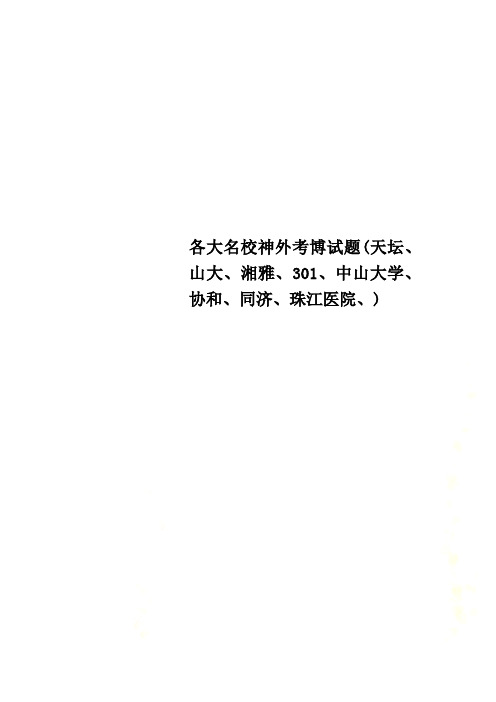
各大名校神外考博试题(天坛、山大、湘雅、301、中山大学、协和、同济、珠江医院、)华中同济2007 博神外一名解(4×5')1. 弥散性轴索损伤2. 迟发性外伤性颅内血肿3. 先天性脑积水4. 颅内压增高二问答1. 颅内压增高的治疗原则(10')2. 听神经瘤的临床分期(10')3. 垂体瘤常用的两种手术方式的注意事项和适应症(20')首医天坛医院2007 博神外名词解释1. Gradinego syndrome2. 功能神经外科3. Nelson‘s syndrome4. GCS5. Von-Hippol-Lindau简答题1. CCF的临床表现2. 延髓网织细胞瘤手术并发症几防治3. 急性EDH和硬膜下血肿的临床鉴别要点4. 脑死亡的标准论述题1. 脑水肿种类病因特点2. 浅谈对神经肿瘤分子病理学的认识中山2009博神外1. 颅咽管瘤的术后并发症2. 脑水肿的分类和发病机理中山2008 博神外24、垂体源性Cushing‘s dise ase 内分泌学检查的临床意义。
25、(Glasgow Liege Coma Scale ,GLCS)格拉斯哥-莱吉昏迷计分方法和临床意义。
中山2006 博神外20、丘脑下部损伤的症状及体征21、试画出Langfitt容积/压力曲线,试述Langfitt试验的过程及临床意义湘雅2005 博神经外科1、癌基因?RAS基因及其的致癌机理?2、抑癌基因?p53基因及其抑癌机理?3、神经干细胞形态,生长特性,及其应用前景?4、床突旁动脉瘤与后交通动脉瘤、脉络膜动脉瘤的鉴别?手术要点?5、DA VF的部位,分型,治疗原则?6、血网的毫发部位,病因,病理,CT及MRI表现,手术要点?7、多形胶母发病率,病理,CTMRI表现,治疗原则?8、DAI?临床和CT表现?病理?9、下丘脑损伤表现及处理?10、外伤或手术后代谢变化的特点及其处理?浙江大学2004 博神经外科一、名词解释1、Foster-Kennedy综合症2、弥漫性轴索损伤3、Brown-sequard、综合症4、运动障碍5、烟雾病二、简答1、WHO关于星形细胞肿瘤的病理分级2、脑水肿的分类3、脑脓肿的临床分期及相应的头颅CT表现4、Key-hole三、问答1、PD的外科治疗2、动脉瘤术中供血动脉的夹闭(夹闭前血供实验,术中监护等)3,高血压脑出血的外科治疗4,松果体区肿瘤的治疗5,垂体腺瘤的病理学分类及相应临床表现华中同济2005 博神经外科一、名解1.颅内压增高2.弥漫性轴索损伤二、问答1、简述急脑疝病理2、简述慢性硬膜下血肿的临床特点及处理原则3、简述脊髓髓内外病变的鉴别诊断4、简述出血性脑卒中的分级及外科治疗原则5、简述听神经瘤的分期及相应临床表现华中同济2004 博神经外科一名词解释(12分)1.头皮血肿2.蛛网膜下腔出血3.血管网状细胞瘤4.脑挫裂伤二问答题(48分)1.椎管内肿瘤的临床表现2.试述脑肿瘤的分类3.脑膜瘤的好发部位4.脑动脉瘤破裂后判断病情的Hunt分级5.脑损伤的分级6.髓母细胞瘤的生物学特点和临床表现7.颅内血肿的手术指征8.弥漫性轴索损伤的特点华中同济 2003 博神外一名词解释(12分)1.头皮血肿2.蛛网膜下腔出血3.血管网状细胞瘤4.脑挫裂伤二问答题(48分)1.椎管内肿瘤的临床表现2.试述脑肿瘤的分类3.脑膜瘤的好发部位4.脑动脉瘤破裂后判断病情的Hunt分级5.脑损伤的分级6.髓母细胞瘤的生物学特点和临床表现7.颅内血肿的手术指征8.弥漫性轴索损伤的特点华中同济2002 博神经外科一、名词解释(每题5分,共10分)1.Lucid interval2.Brown-Sequard’s syndrome二、问答题(共60分)1.试述垂体瘤的分类和临床表现。
中山医科大学博士研究生入学考试神经病学试题
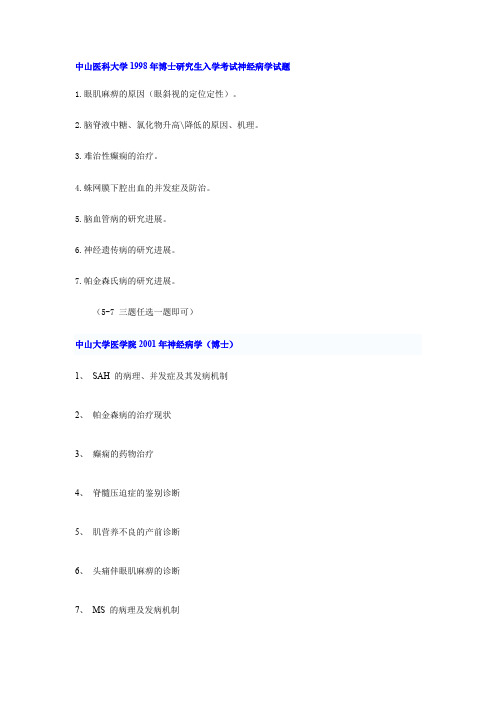
中山医科大学1998年博士研究生入学考试神经病学试题
1.眼肌麻痹的原因(眼斜视的定位定性)。
2.脑脊液中糖、氯化物升高\降低的原因、机理。
3.难治性癫痫的治疗。
4.蛛网膜下腔出血的并发症及防治。
5.脑血管病的研究进展。
6.神经遗传病的研究进展。
7.帕金森氏病的研究进展。
(5-7 三题任选一题即可)
中山大学医学院2001年神经病学(博士)
1、SAH 的病理、并发症及其发病机制
2、帕金森病的治疗现状
3、癫痫的药物治疗
4、脊髓压迫症的鉴别诊断
5、肌营养不良的产前诊断
6、头痛伴眼肌麻痹的诊断
7、MS 的病理及发病机制
中山大学医学院2005年神经病学(博士)
1.PD的临床表现
2.MS的病因及免疫干预治疗
3.结脑的临床表现、确诊依据及治疗原则
4.基底动脉尖综合症的损伤血管、临表
5.神经遗传病的分类及遗传方式。
各校神经病学考博试题
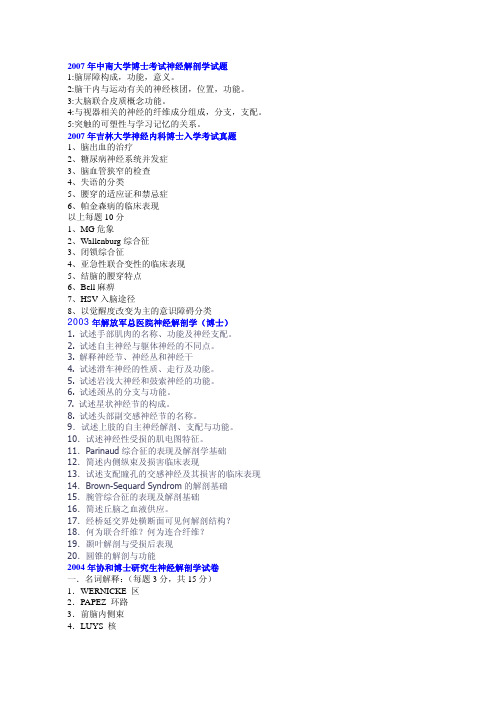
__________________,连接两侧海马的是__________________。
18.
支配颊肌运动的是__________________,管理颊部躯体感觉的是__________________,管理舌后
1/3 感觉的是__________________,管理舌前 2/3 味觉的是__________________。
_____________________ , 下 行 纤 维 包 括 _____________________ 、 _____________________ 和
_____________________。
10.
与海马CA1区相接的是__________,与CA4相接的是__________,海马旁回与__________相接。海
马结构的主要传出纤维是__________,最终止于__________和__________。
11.
丘脑束又称__________区,包括__________、__________和__________,这些纤维分别进入丘脑
_____________________等核群。
12.
海 绵 窦 内 穿 行 的 结 构 有 __________ 、 __________ 、 __________ 、 __________ 、 __________ 和
1.名词 Gene array fMRI Event-related Potential Neural Plasticity 2.脊髓背角 C 纤维的主要突触递质是什么?请设计不同实验方法予以证实? 3.根据目前帕金森病的研究进展,简述未来帕金森病的可能治疗措施。
A.
颈内动脉
B.
大脑前动脉
中山大学医学院解剖学考博专业课论述题
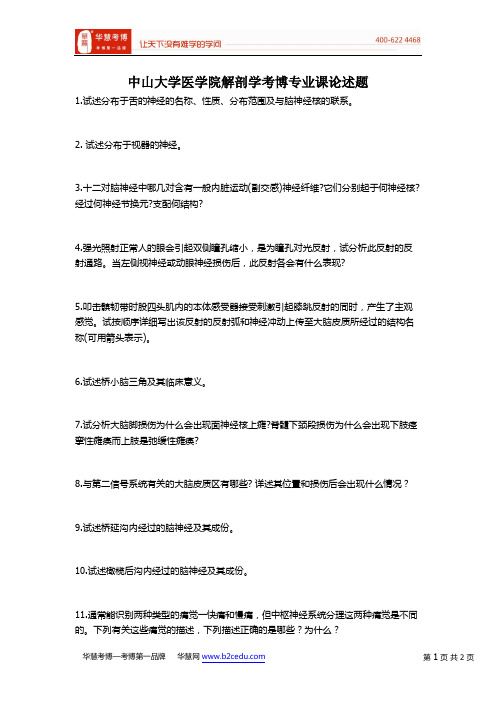
中山大学医学院解剖学考博专业课论述题1.试述分布于舌的神经的名称、性质、分布范围及与脑神经核的联系。
2. 试述分布于视器的神经。
3.十二对脑神经中哪几对含有一般内脏运动(副交感)神经纤维?它们分别起于何神经核?经过何神经节换元?支配何结构?4.强光照射正常人的眼会引起双侧瞳孔缩小,是为瞳孔对光反射,试分析此反射的反射通路。
当左侧视神经或动眼神经损伤后,此反射各会有什么表现?5.叩击髌韧带时股四头肌内的本体感受器接受刺激引起膝跳反射的同时,产生了主观感觉。
试按顺序详细写出该反射的反射弧和神经冲动上传至大脑皮质所经过的结构名称(可用箭头表示)。
6.试述桥小脑三角及其临床意义。
7.试分析大脑脚损伤为什么会出现面神经核上瘫?脊髓下颈段损伤为什么会出现下肢痉挛性瘫痪而上肢是弛缓性瘫痪?8.与第二信号系统有关的大脑皮质区有哪些? 详述其位置和损伤后会出现什么情况?9.试述桥延沟内经过的脑神经及其成份。
10.试述橄榄后沟内经过的脑神经及其成份。
11.通常能识别两种类型的痛觉一快痛和慢痛,但中枢神经系统分理这两种痛觉是不同的。
下列有关这些痛觉的描述,下列描述正确的是哪些?为什么?12.试述在孤束核发生突触的传入神经元是哪些反射的传入部分?13.根据三叉神经的功能, 若损伤三叉神经,引起的感觉和反射障碍的情形怎样?为什么?14.脑干中主要纤维束交叉有哪些?其位置和性质如何?12.右侧半脊髓胸4~5节段半横断后,在横断平面以下 (1)身体何侧丧失了痛温触觉?(2)何侧肢体丧失了本体觉?(3)何侧肢体不能随意运动?这时扣击该侧下肢的髌韧带还能不能引起髌反射(临床上又名膝跳反射)? 为什么?13.请写出听声音转头、转眼的反射径路。
14.试述面瘫有几种形式, 分别有什么表现?15. 试述躯体运动神经、内脏运动神经之间的不同点?16.如果一位患者患右侧面神经周围性麻痹,刺激双眼角膜会产生什么情况?为什么?17.解释眶上裂综合征、岩尖综合征和颈静脉孔综合征的解剖学基础。
- 1、下载文档前请自行甄别文档内容的完整性,平台不提供额外的编辑、内容补充、找答案等附加服务。
- 2、"仅部分预览"的文档,不可在线预览部分如存在完整性等问题,可反馈申请退款(可完整预览的文档不适用该条件!)。
- 3、如文档侵犯您的权益,请联系客服反馈,我们会尽快为您处理(人工客服工作时间:9:00-18:30)。
中山大学
2018 年攻读博士学位研究生入学考试试题
第1页 共1页
考试科目:神经病学
注意:所有答案一律写在答题纸上,写在试题纸上或其他地方一律不给分。 一、名词解释 1. lennox gaustant 2. doll eye reflection 3. 延髓腹侧综合征 4. 多巴反应性肌张力障碍 5. 帕金森病的冻结现象 6. 脊髓的间歇性跛行 7. 放射性神经系统疾病 8. 构音障碍手笨拙综合征 9. 体象障碍 10. 胆碱能危象 二、简答题 1. 癫痫的离子通道发病机制。 2. 偏头痛典型的临床表现。 3. TOAST 和 OPSC 分型。 4. 帕金森病的非运动症状。 5. 多发性硬化的治疗原则。 三、问答题 1. 呼吸泵衰竭的治疗原则。 2. 颅内静脉系统血栓需要做的主要辅助检查。 3. 多发性神经病的病因分类。 4. 病例分析: 23 岁女性,抽搐伴精神行为异常 17 天,查体:精神行为异常,认知功能障碍,
锥体及锥体外系均受损,双上肢及左下肢肌力 2 级,右下肢肌力 3 级,双下肢腱反射亢进, 四肢肌张力不高,病理征未引出,kerning 可疑阳性。辅助检查:3 个月前盆腔 b 超可见卵巢 包块。 诊断和鉴别诊断,还需要做哪些检查。
第1页 共1页
